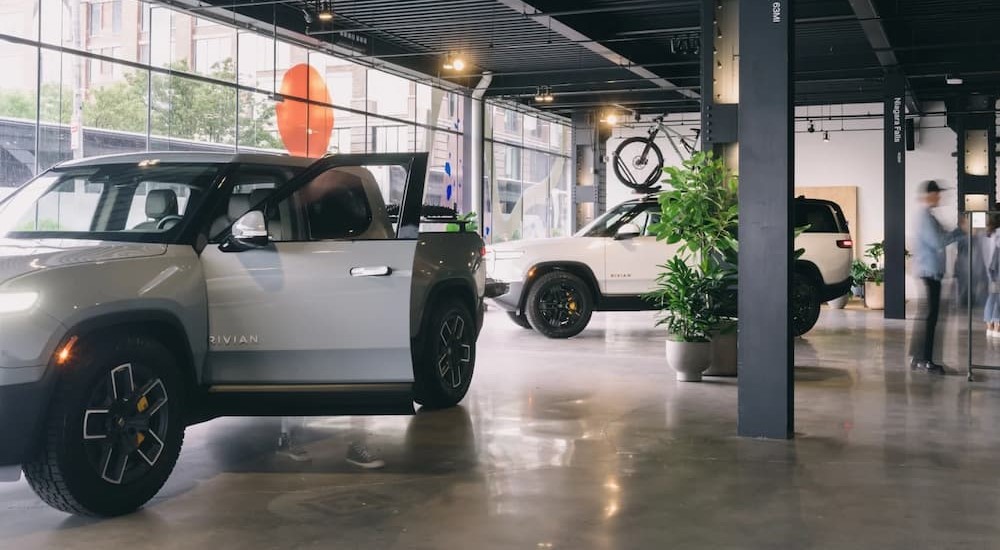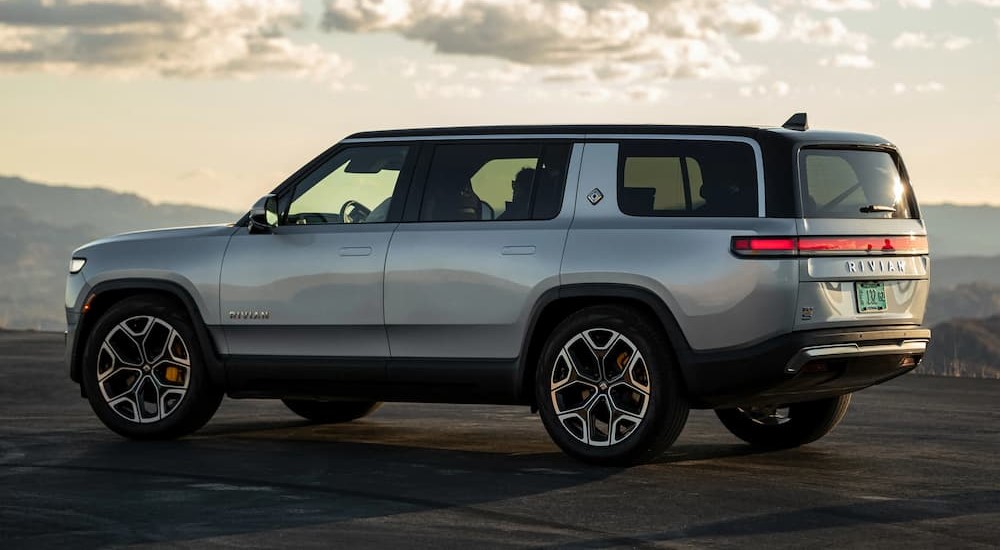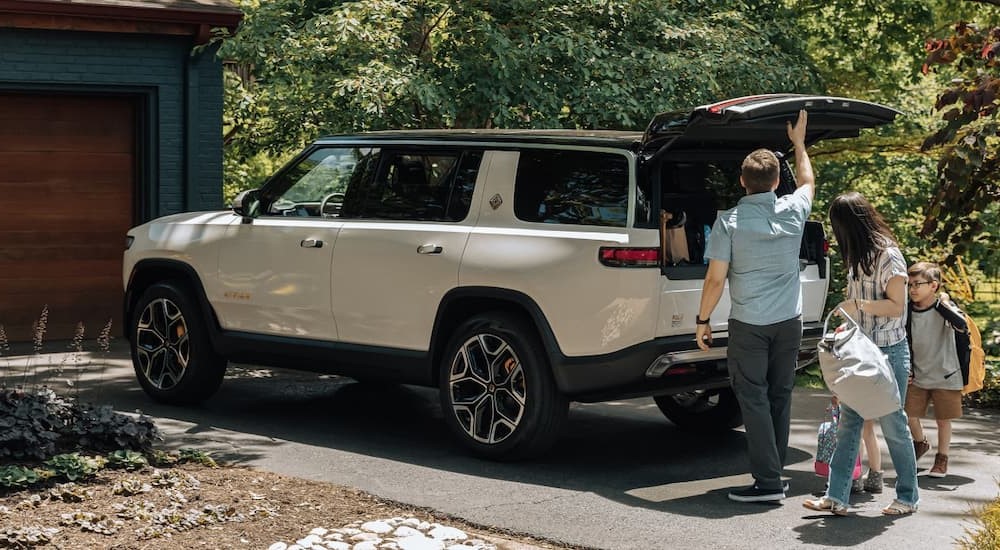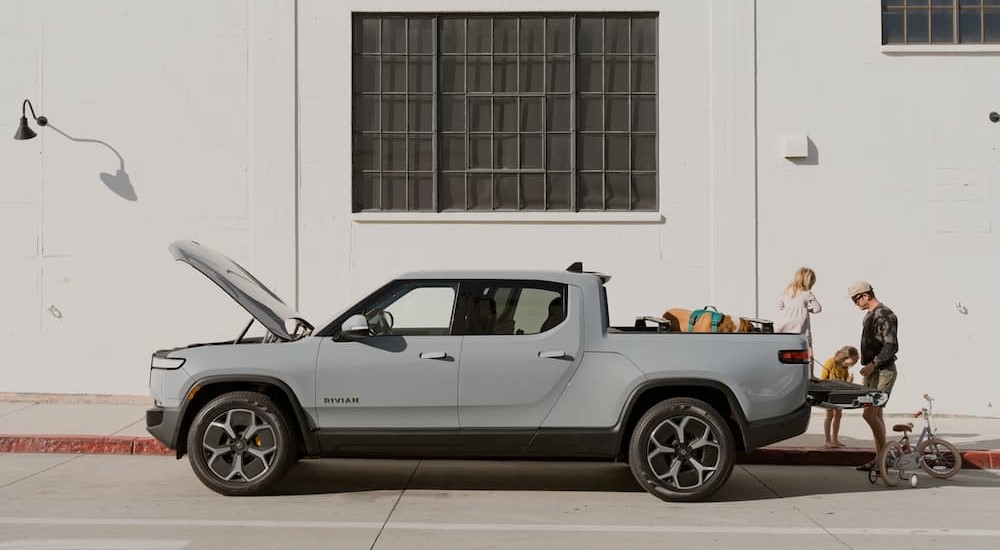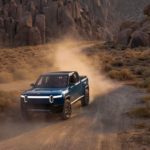Everyone loves an underdog story, but one ambitious startup is having a tough year as it struggles to meet demand, and its stock price continues to plummet. Rivian started out with a promising business model, producing a line of luxurious all-electric pickups and SUVs, but market forces, recalls, and supply chain issues have seen the brand face some tough economic realities in the last few years. The automaker’s market cap has tumbled by 115 percent from its all-time high, with Rivian’s stock plummeting 49 percent in the last 12 months.
In many ways, Rivian’s fall from grace can’t come as much of a surprise. By many accounts, the company was massively overvalued when it completed its $12 billion initial public offering (IPO) in 2021, a number that only rose as the EV maker’s stock briefly became Wall Street’s newest darling. At one point, Rivian––which had yet to actually deliver a single vehicle to consumers––boasted a stock market value twice that of Ford Motor Company’s $58 billion. Today, Rivian’s market cap is down to a paltry $14.8 billion, decimating the company’s stock value in just a little more than two years.
It’s a stunning fall from grace for a brand that many investors once hoped was the new Tesla and one that’s spurred new debates about the company’s viability in an increasingly competitive EV market. What went wrong at the electric vehicle manufacturer, and how can other automotive startups learn from Rivian’s struggles? We’ll take a closer look at some of the factors that have contributed to the company’s plunging value and see if there’s any light at the end of the tunnel for the startup EV brand.
Rising Rivals
In some ways, Rivian is a victim of the EV sector’s success. More and more legacy automakers have committed to the EV trend in the last few years, with major brands like General Motors announcing plans to phase out all traditional gas-powered vehicles by 2035. With enticing new offerings like the Ford F-150 Lightning and Kia EV6 hitting the streets, Rivian is quickly losing its edge. While Rivian’s pickup and SUV offerings have managed to carve out a niche on the luxury end of the market, it’s too early to tell whether that will be enough to carry Rivian through a rocky start.
The ongoing electrification of popular pickup models has dulled the brand’s appeal in the eyes of some consumers, many of whom would rather try out a new EV version of the same pickup they’ve been driving than suffer through the growing pains that come with a startup. Sure, there will always be some iconoclasts out there who will flock to a new brand simply for the novelty, but it’s tough to see how that demographic can carry an entire company.
Supply Chain Issues
Supply chain issues have plagued the automotive industry stretching back to the start of the Covid-19 pandemic in early 2020. Even now, three years removed from the days of shuttered factories and empty warehouses, automakers are still struggling to recover and bring production back to pre-pandemic levels. This issue has had an effect on automakers big and small, but it has been particularly trying for startups like Rivian, who are struggling to produce enough vehicles to hit that all-important brand tipping point.
“The issue we have is that the supply constraint is, by far and away, the biggest constraint,” Rivian’s Chief Executive RJ Scaringe said in a March conference call with analysts. “We wish we could have the components still to fully run the plant across all lines, across multiple shifts, but that’s not the case.” The brand has failed to meet analysts’ expectations over the last two years, falling 663 units short of its 25,000-vehicle production target in 2022. Currently, 2023 isn’t looking much better, with the company announcing it aims to produce 50,000 vehicles this year instead of the 67,000-plus forecasted by analysts.
The Tesla Effect
For automotive brands of all stripes, it’s tough to escape Tesla’s ever-present influence. As the first major success story in today’s EV renaissance, the brand has been a trailblazer in more ways than one. Tesla’s direct-to-consumer sales model has inspired a new breed of automotive startups that aim to cut traditional dealerships out of the equation entirely, eliminating the middleman and allowing the automaker to reap the profits.
While Rivian has embraced the same direct sales approach as Tesla, it’s the latter’s recent price cuts that have really disrupted the EV sales model. Tesla rolled out a massive discount for all of its models in January, with additional rounds of cuts in March and April. These discounts worked like a charm, netting Tesla some 422,000 sales over the first quarter of 2023 alone. Some EV producers have followed suit, introducing or contemplating price cuts in order to keep pace with Tesla, but Rivian has been a defiant holdout.
In late February, Scaringe announced that the company would not enter the EV pricing wars, citing a strong backlog of sales and the high overall value of its vehicles at their current price. “The demand backlog we have is very robust,” Scaringe said in March. “It gives us a clear line of sight well into 2024.” This strategy could be a boon to Rivian in the long run––some analysts have predicted that Tesla’s price cuts could see the company’s year-over-year earnings decline by as much as 20 percent––but in the short-term, it’s not making things any easier for the fledgling company.
Recall Woes
If there’s one word that can set any auto industry exec on edge, it’s “recall.” Manufacturing errors can be tough for any company but can hit smaller producers especially hard, as they often lack the financial strength and infrastructure needed to weather the storm.
In less than two years on the market, Rivian has already suffered through two major recalls. The first, coming in October 2022, saw the brand recall more than 12,000 vehicles due to potentially mistorqued suspension bolts. Less than six months later, the company was in trouble once again, recalling 13,000 R1T and R1S models due to a potential issue with a seatbelt sensor that could cause the airbag to not properly deploy in the event of a crash.
The 13,000 figure might seem thankfully low for a recall, but given Rivian’s short history, it actually encompasses almost half of the vehicles sold by the brand since it first started delivering trucks in late 2021. According to internal estimates, Rivian says that only one percent of the 13,000 vehicles will need to be fixed, but inspecting every unit is going to cost the EV brand precious time––and money––that it can hardly afford.
Rivian isn’t the only EV maker to deal with a massive recall in recent years. Tesla faced its own recall issues in early 2023, including recalling over half a million vehicles for failing to comply with mandated Pedestrian Warning System sound requirements. According to a recent iSeeCars study, the Musk-led brand also has the most projected lifetime recalls, suggesting that the “move fast and break things” ethos so beloved by the startup world might not be a great model when it comes to the auto industry.
Interest Rates
Starting at $73,000, the Rivian R1T pickup is far from the cheapest option on the market. Sure, the luxury truck segment is as strong as ever, with drivers gravitating towards fully-loaded pickups in record numbers, but from an economic standpoint, it’s not a great time to be fancy. Rising interest rates have put Rivian’s ultra-luxe trucks well outside the range of the average driver as auto loans balloon into historic territory, creating a tough market all around. There’s no sign of relief on the horizon with the Federal Reserve continuing to raise interest rates. Now at their highest level since 2006, the lofty interest rates are bad news for the industry as a whole, but especially concerning when it comes to the future of Rivian.
Shaky Investors
Rivian’s stock woes have rattled investors and analysts alike, creating some shaky ground on which to try to build the company. Following the recent recall announcement, Rivian shares were downgraded from a Buy to a Hold by RBC Capital Markets, according to analyst Tom Narayan. “Near-term, we see limited catalysts to accelerate profitability and believe margins will remain constrained,” says Narayan.
That same analysis sliced the company’s stock price targets in half, from a projected $24 per share to just $14 per share. Other firms have echoed the sentiment, with Piper Sandler announcing a similar downgrade in April. Rivian has long faced doubt about its potential profitability, failing to meet production goals and burning through cash at a troubling clip. However, at the time of writing, Rivian’s economic forecast includes 13 Buy ratings, seven Hold ratings, and only two Sells, according to Bloomberg.
Signs of Hope
It’s not all doom and gloom over at Rivian HQ. There are a few promising ventures on the horizon for the startup automaker, and no matter how bad things get, Rivian does have plenty of support from a deep stable of five-star investors. Amazon, for instance, owns an estimated 17 percent of the company. The Amazon partnership is particularly interesting, with Rivian teaming up with the online retail giant to produce a line of electric delivery vans dubbed the Rivian EDV. Given the rise of Amazon as the go-to source for virtually all consumer goods over the last decade, the Amazon-Rivian relationship could well be a turning point for the startup.
On the production end, there are some glimmers of hope emanating from Rivian’s Normal, IL, production facility. Purchased in 2017 for $16 million, Rivian is already planning a 623,000 sq.ft. addition to the facility that brings the total size to some 3,900,000 sq.ft. There’s also an announced $5 billion battery and assembly plant in Georgia that the company says will go online in 2024 with plans to manufacture as many as 400,000 vehicles per year. Funded by $1.5 billion in tax credits and local incentives that likely represent the largest such package in state history, the Georgia project could be the perfect solution to Rivian’s struggles scaling up.
Forecast Unclear
It’s too early to tell what the future holds for Rivian, but barring a major market upswing, a generous new EV tax credit program, or the like, things certainly aren’t looking good. With increased competition from established auto brands, record-high interest rates, supply chain and recall issues, and the unpredictable wildcard that is Tesla to contend with, it is certain to be an uphill battle. These concerns can easily have a compounding effect on an already-struggling company, with news of Rivian’s troubles instilling a lack of confidence in prospective buyers. After all, who is going to drop $75,000 on a truck from a company that could well go under, making repairs expensive, if not impossible. We’re hoping for the best when it comes to the future of Rivian, largely because consumers stand to benefit from a high level of competition within the industry. But if the age of startups has taught us anything, it’s that you can never know whether a brand is going to achieve unicorn status or be relegated to the annals of automotive history.

